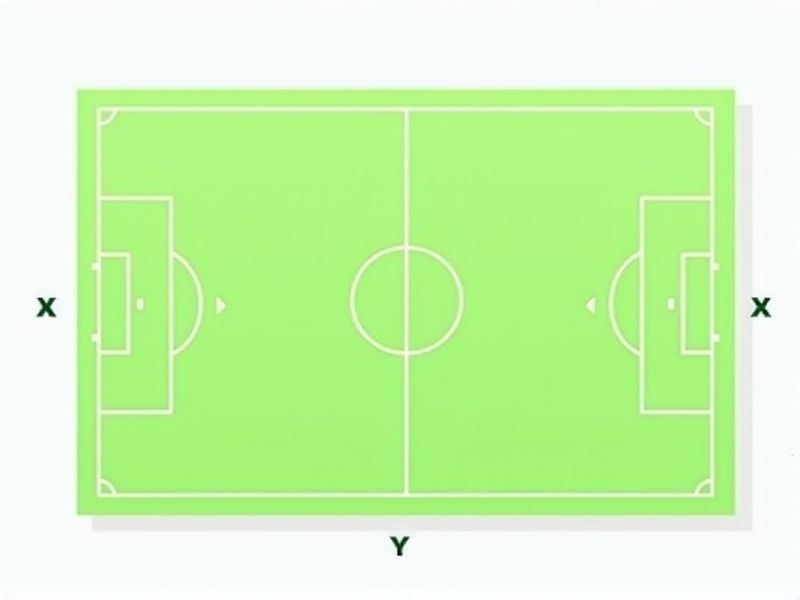
The standard dimensions of a rugby field, also known as a pitch, are set by World Rugby to ensure consistency across all levels of the game. The field of play is typically 100 meters long from try line to try line and 70 meters wide, with in-goal areas at each end that are between 10 to 22 meters deep. Clear field markings include the halfway line, 22-meter lines, 10-meter lines, and dead-ball lines to help guide gameplay. Knowing these standard measurements is helpful for players, coaches, and referees to maintain proper spacing, alignment, and strategy during matches.
Sideline Length: 100 Meters
The standard rugby field features a length of 100 meters between the two goal lines, providing ample space for dynamic gameplay. Each sideline runs parallel to the goal lines, contributing to the rectangular shape of the field. The total width of the field can vary between 68 meters, ensuring that the playing area meets international regulations. Maintaining these dimensions is crucial for ensuring fair play and competitive balance in all levels of rugby, from local clubs to international tournaments.
Try Line Width: 68-70 Meters
The standard width of a rugby field is measured at 68 to 70 meters, providing ample space for players to maneuver during the game. This measurement ensures that both teams can effectively utilize the width for strategic plays, such as creating overlaps or exploiting gaps in the defense. The dimensions significantly contribute to the fast-paced and dynamic nature of rugby, where team coordination and positioning are crucial. For your training sessions, it's important to replicate these field dimensions to enhance your understanding of spacing and teamwork.
In-Goal Area Depth: 10-22 Meters
The in-goal area of a rugby field has a standard depth that ranges from 10 to 22 meters. This specific dimension plays a crucial role in gameplay, as it influences how tries are scored and the overall strategic tactics used by teams. According to World Rugby, the total length of a rugby field, including the in-goal areas, is between 122 and 135 meters. Understanding these measurements can enhance your appreciation of the sport's dynamics and field layout.
Dead-Ball Line: Beyond In-Goal
The dead-ball line marks the outer boundary of the in-goal area in rugby, positioned 5 to 11 meters behind the goalposts. When the ball crosses this line, play is immediately stopped, and the defending team may take a dropout from their 22-meter line. The width of the in-goal area typically ranges from 6 to 22 meters, ensuring enough space for players to score tries and engage in dynamic play. Understanding the location and significance of the dead-ball line is crucial for strategic gameplay and can impact scoring opportunities in your matches.
22-Meter Line: Parallel To Try Line
The rugby field is defined by specific lines, with the 22-meter line being crucial for gameplay. Positioned parallel to the try line, this line marks the territory for both defensive and offensive strategies. If your team is within this zone, you have unique options for set plays, including kick strategies or tactical maneuvers. Understanding the significance of the 22-meter line can enhance your team's performance and decision-making during matches.
10-Meter Line: Midfield
The rugby field features a critical 10-meter line that serves as a key measurement for gameplay, especially during restarts. This line is positioned at the halfway point between the two goal lines, facilitating the strategic organization of both teams, as players must retreat 10 meters during a kickoff. The total length of a rugby field is 100 meters between the goal lines, with a width of 74 meters, making the midfield line pivotal for maintaining the flow of the game. Understanding the significance of this 10-meter line can enhance your strategy and positioning during matches.
Halfway Line: Center Of Field
The halfway line on a rugby field, situated exactly at 50 meters from each goal line, serves as the center point for both teams. This line is crucial for kick-offs, where play begins at the center, and for restarts after points are scored. Dominance in this central area often dictates the flow of the game, allowing teams to establish territorial advantage. Understanding the significance of the halfway line can enhance your strategic approach during matches, as it is key to both offensive and defensive plays.
Goal Posts Width: 5.6 Meters Apart
The standard rugby field features goal posts that are 5.6 meters apart, a critical measurement for ensuring compliance with the official rules of the game. This width is designed to challenge kickers while also providing enough space for accurate scoring opportunities. The height of the posts is at least 3.4 meters, contributing to an overall competitive environment. Understanding these specifications is essential for teams and players who wish to excel in their performance on the field.
Post Height: Minimum 3.4 Meters
The standard height for rugby goalposts is a minimum of 3.4 meters from the ground, ensuring that the posts are suitable for all levels of play. Each goalpost consists of two vertical uprights and a horizontal crossbar, with the crossbar set at 3 meters above the ground. The width between the two uprights measures 5.6 meters, creating a clear target for successful conversions and penalty kicks. Adhering to these specifications is essential for properly officiated games and maintaining consistent playing conditions.
Crossbar Height: 3 Meters Above Ground
The standard height of the rugby crossbar is set at 3 meters above the ground, providing a clear guideline for both amateur and professional play. This measurement is essential for maintaining consistency in scoring opportunities during matches, as players aim to kick the ball over the bar for points. The crossbar, along with the posts, forms the goal structure, crucial for successful conversions and penalty kicks. Understanding these dimensions can enhance your appreciation of the game's strategy and skill levels.
